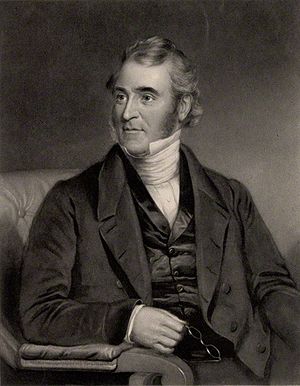John Morison (pastor) facts for kids
Quick facts for kids
John Morison
|
|
|---|---|

John Morison, engraving by John Whitehead after Henry Room
|
|
| Born | 1791 |
| Died | 13 June 1859 |
| Nationality | British |
| Occupation | Pastor |
| Known for | London Missionary Society; Abolitionism |
John Morison (1791–1859) was a Scottish Protestant minister who lived in London. He was a well-known editor of the Evangelical Magazine & Missionary Chronicle. He also wrote many books about religious topics and people's lives. Morison was a Congregational pastor at Trevor Chapel in Knightsbridge, London. He was famous for his strong and passionate speeches, his support for the London Missionary Society, and his fight to end slavery in the USA.
Contents
Who Was John Morison?
John Morison was born in Scotland in 1791. He became one of the main leaders of the Congregational church in London during the mid-1800s. He was also an important committee member of the London Missionary Society. This group worked to spread Christianity around the world.
Morison became a minister on February 17, 1815. He started as a pastor at Union Chapel in Chelsea. In 1816, a bigger church was built for him in the same area. This new church, Trevor Chapel, opened at the end of 1816. He served as a minister there for over 40 years. From about 1827 to 1857, he was also the editor of the Evangelical Magazine.
Fighting for Freedom
John Morison was a strong supporter of ending slavery. He worked with other leaders from the London Missionary Society, like Thomas Raffles and Alexander Fletcher.
An escaped slave named Moses Roper came to Britain seeking help. He brought letters of introduction to Morison, Raffles, and Fletcher. Roper wanted their support to promote the cause of freedom and end slavery. Morison was asked to help edit Roper's life story, called A Narrative of the Adventures and Escapes of Moses Roper. Because Morison was ill, another minister, Dr. T. Price, finished the task.
Dr. Morison was a very enthusiastic public speaker. People often asked him to speak at religious meetings in London, especially at Exeter Hall. He spoke strongly against slavery. For example, in a speech after the death of King George IV in 1830, he said:
- Our nation made it illegal to trade people from Africa many years ago. But slavery still exists in our West Indian colonies. It seems hard to stop, no matter what we try. Oh, cruel, terrible slavery! You have caused so much pain to millions of people! How many hearts have you left broken and hopeless on Africa's shores? Christians should wake up and act on this issue. Let our strong beliefs finally achieve what politics alone cannot.
His Church: Trevor Chapel
Dr. Morison's church, Trevor Chapel, was located at Trevor Square in Knightsbridge, Kensington. The building was torn down in the 1950s. It was later taken over by the Harrods department store.
Before Trevor Chapel, Morison was a minister at Union Chapel. He left that church, and some of his followers joined him. They met in a factory during 1816 while their new church was being built. Trevor Chapel opened in December 1816. A member of his church, John Souter, largely paid for it.
The chapel was made bigger in the 1830s. Schoolrooms were added by the end of that decade. After Dr. Morison's death, a gallery was added to the church in the 1860s. His co-pastor took over as the minister of the chapel. This co-pastor also became the new editor of the Evangelical Magazine and Missionary Chronicle.
Later Life and Legacy
John Morison passed away in London on June 13, 1859. He is buried in Abney Park Cemetery in Stoke Newington, London. This cemetery is a non-religious Victorian garden cemetery for Congregationalists. His grave has a white marble memorial.
Family
In 1815, John Morison married Elizabeth Murray. She was the second daughter of James Murray from Banff. They had several children together.
Writings
- Morrison, John (c.1830s-50s), The Evangelical Magazine and Missionary Chronicle, London:Ward & Co.

